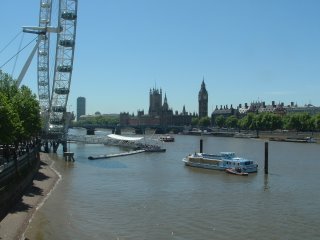M. suggested we all meet at the Thameside to take advantage of the lighter, warmer evenings. Our first Thursday Club of 2005 in the outdoors. True to form, as I left school at about 5.20pm the thunder and lightening started. R. and I took the ferry from Canary Wharf to London Bridge (a much underused means of transport). The water looked quite choppy (read weather above) but the journey was remarkably smooth.
Sat indoors, we could glimpse, over the Bridge and through the relatively new buildings, the “Fish Street Pillar”. The Monument was built to commemorate the Fire which swept through London in September 1666. At 202 feet the height of the building is equal to the distance from the pillar to the outbreak of the fire in nearby Pudding Street. Sir Christopher Wren, the renowned architect and scientist, and Robert Hooke, the lesser known scientist and architect, designed the Portland Stone tower collaboratively.
Hooke was the most prolific inventor of scientific instruments in the Seventeenth Century. For him the tower served another purpose – it gave him the opportunity to carry out otherwise impossible experiments. The steps were placed a very specific six inches apart so experiments in pressure could be conducted, pendulums could be swung in the vertical shaft and the golden urn crowning the monument had a hinged trapdoor through which a telescope could be directed. His laboratory was located in an underground cellar. Unfortunately for Hooke the building was not stable enough to give readings of the accuracy he required.
He seems to have been a rather cantankerous and argumentative soul. He frequently fell out with his fellow scientists – Christopher Huygens and Isaac Newton to name but two. Newton, Wren and Hooke were all members of the newly-founded Royal Society – Hooke starting out as an employee in the post of Curator of Experiments before rising to the equal footing of Fellow. He was also Professor of Geometry at Gresham College. (The college, named after its founder Sir Thomas Gresham, has offered free lectures to the public for over 400 years – and still does). Hooke had formerly been assistant to Robert Boyle. He spent years on his theories of light, gravitation and the movement of the sun and planets (he watched Mars and first sighted a double star).
Hooke’s inventions include: the spring control of balance wheels in watches; the compound microscope; the wheel barometer; Hooke’s joint (found in all cars apparently); the first reflecting telescope; and, the term ‘cell’.
Popular opinion at the time of the Fire believed Catholics were behind the destructive force. A young French watchmaker confessed to starting the blaze and promptly swung for the crime. The fact he wasn’t even in the country when the fire took place was conveniently overlooked by the authorities. An inscription at the base of the tower which blamed the “malice and treachery of the Popish faction” was belatedly removed in 1831.
The viewing platform was enclosed in 1842 – only after a maid had thrown herself off the gallery.
Only worth the climb on a good, clear day. I have heard you now receive a certificate to say you reached the top. You’ll have to take my word for it – I managed it with my family and German penfriend about 15 years ago. Probably a damn site cheaper then too!
It wasn’t all talk of history and London. R. discovered I can bake. Not only did I win a prize for my chocolate hedgehog cake in the Christmas fête (as demonstrated on Blue Peter), Wayne P’s mum paid me to make one for their Christmas table. Pretty impressive for a ten-year old. My cousin’s first communion cake went down quite well a few years later too.
Subscribe to:
Post Comments (Atom)

1 comment:
In October 2001 I went along with my brother and his class (in Northbury) on a school trip to The Monument. It was designed by Sir Christopher Wren and built between 1671 - 1677. It was erected as a memorial of the Great Fire. It is 202 feet high - The exact distance between it and the site in Pudding Lane where the fire began which we also glanced at briefly (all offices there now, no bakers)! The column is surmounted by a drum and copper urn from which flames amerge, symbolising the great fire. We climbed the 311 steps to the top and even received a document certifying that!
Post a Comment